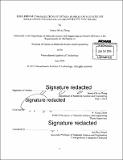Equilibrium configurations of oxygen bubbles on surfaces for applications in nanostructured hematite electrodes
Author(s)
Zheng, Jennie Olivia
DownloadFull printable version (4.159Mb)
Other Contributors
Massachusetts Institute of Technology. Department of Materials Science and Engineering.
Advisor
W. Craig Carter.
Terms of use
Metadata
Show full item recordAbstract
The variability of a nanostructured material's fundamental properties as compared to its bulk state has led to the rich field of nanotechnology and the quest to uncover unique properties of structures at the nanoscale. An active application for these materials is in the nanostructuring of [alpha]-Fe₂O₃ (hematite) for photoelectrochemical (PEC) splitting of water to generate hydrogen. A model of a bubble on a nanorod was developed in this work to facilitate the understanding of equilibrium configurations of oxygen bubbles on a nanostructured hematite electrode. The equilibrium configurations are computed using Surface Evolver, a program which models surfaces shaped by various constraints and forces. A nanorod with a top surface dimension of 100 by 100 nm was the subject of the bulk of this work. The energy of different starting configurations of the bubble and increasing volume of the bubble were compared to that of a free spherical bubble. The energy of the bubble approaches the total surface energy of a free spherical bubble, indicating that a bubble that has nucleated on the surface of a nanorod will approach a shape that has nearly the same energy as a detached spherical bubble. For applications in PEC splitting of water, this result indicates that from an equilibrium and lowest energy perspective, an oxygen bubble could nucleate on the surface of a nanorod, grow in volume, and detach or pinch-off from the nanorod.
Description
Thesis: S.B., Massachusetts Institute of Technology, Department of Materials Science and Engineering, 2015. Cataloged from PDF version of thesis. Includes bibliographical references (page 32).
Date issued
2015Department
Massachusetts Institute of Technology. Department of Materials Science and EngineeringPublisher
Massachusetts Institute of Technology
Keywords
Materials Science and Engineering.